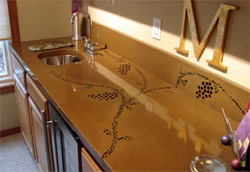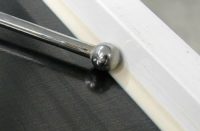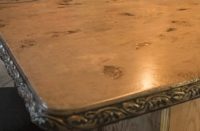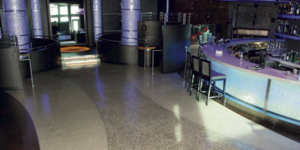As Bob Chatterton, co-owner of Surface 519, puts it, “Countertops are just a sealing nightmare. It’s asked that they be resistant to everything under the sun.”
So it seems a natural correlation to make a stain- and scratch-resistant coating that uses the sun – or at least the sun’s ultraviolet rays.
 Surface 519’s Counter-UV, a sealer for countertops, cures using UV light and gives a natural look to a surface. Photoinitiators in the hybrid nanotechnology-resin sealer allow the coating to harden almost instantly when exposed to a certain wavelength of light.
Surface 519’s Counter-UV, a sealer for countertops, cures using UV light and gives a natural look to a surface. Photoinitiators in the hybrid nanotechnology-resin sealer allow the coating to harden almost instantly when exposed to a certain wavelength of light.
Without the special curing lamp, Counter-UV won’t cure. “That can be a good thing in the fact that it allows you to work it into pinholes and deal with other nuances of sealing concrete,” Chatterton says. “It gives you as much time as you need to make that happen.”
Counter-UV works similarly to other countertop sealers in that it can be rolled or sprayed onto the surface. It resists stains and scratches, as well as acidic foods and condiments, Chatterton says. “It pretty much covers anything you would use a kitchen countertop for.”
Another of the product’s selling points is the look it leaves on concrete. “People want (the concrete) to look as natural as possible,” Chatterton says. “This looks and feels natural. I’ve had people look at it and swear there wasn’t even a coating on there.”
Counter-UV typically is applied at about 3 to 5 mils thick, but after it has been absorbed and sanded, only 1 or 2 mils of coating will remain on the surface. Although the cost of Counter-UV is comparable to other countertop sealers, the special curing lamp costs about $2,900. However, Chatterton believes the sealer is worth the price. “It answers all the questions that everybody has,” he says. “It enhances color, looks natural, is scratch resistant and stain resistant, offers a fast cure and turnaround, and is completely VOC free.”
Chatterton says the issue most UV coatings for concrete have to overcome is adhesion. Short wet-out times and intense cure conditions can produce a compromised bond. “Our nanotechnology not only overcomes this risk but does so without the use of separate primers or conditioners,” he says. “One-step single-component application takes out all the risk.”
www.surface519.com

















